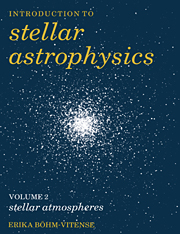Book contents
- Frontmatter
- Contents
- Preface
- 1 Stellar magnitudes and stellar colors
- 2 Stellar spectra
- 3 Temperature estimates for stars
- 4 Basics about radiative transfer
- 5 Radiative transfer in stellar atmospheres
- 6 The depth dependence of the source function
- 7 The continuous absorption coefficient
- 8 The influence of the non-greyness of the absorption coefficient
- 9 The pressure stratification
- 10 Theory of line formation
- 11 The hydrogen lines
- 12 Spectrum analysis
- 13 Basics about non-local thermodynamic equilibrium
- 14 The hydrogen convection zone
- 15 Stellar chromospheres, transition layers, and coronae
- 16 Stellar winds
- Problems
- Appendix LTE model stellar atmospheres
- References
- Index
12 - Spectrum analysis
Published online by Cambridge University Press: 08 February 2010
- Frontmatter
- Contents
- Preface
- 1 Stellar magnitudes and stellar colors
- 2 Stellar spectra
- 3 Temperature estimates for stars
- 4 Basics about radiative transfer
- 5 Radiative transfer in stellar atmospheres
- 6 The depth dependence of the source function
- 7 The continuous absorption coefficient
- 8 The influence of the non-greyness of the absorption coefficient
- 9 The pressure stratification
- 10 Theory of line formation
- 11 The hydrogen lines
- 12 Spectrum analysis
- 13 Basics about non-local thermodynamic equilibrium
- 14 The hydrogen convection zone
- 15 Stellar chromospheres, transition layers, and coronae
- 16 Stellar winds
- Problems
- Appendix LTE model stellar atmospheres
- References
- Index
Summary
The Balmer jump and the hydrogen lines
Hot stars
In Section 8.2 we saw that the Balmer discontinuity is determined by the ratio of the continuous absorption coefficients on both sides of this discontinuity. For hot stars we derived that the discontinuity is determined by the ratio of the number of hydrogen atoms in the second quantum level (absorbing shortward of 3647 Å) to the number of hydrogen atoms in the third quantum level (absorbing on the long wavelength side of 3647 Å). This ratio is completely determined by the temperature. For the B stars the temperature can in principle be determined from the Balmer discontinuity alone.
The pressure can be determined from the electron density ne. For late B stars, for instance, the hydrogen is completely ionized, while the helium is not. Therefore, we know that ne = H+ and N = ne + H+ + He = ne + H+ + 01H+ if the abundance of helium is 10% by number of atoms. With this we find
and, of course,
As we saw in the previous chapter, the number of free electrons can be determined from the hydrogen lines in two ways: either from the number of visible Balmer lines by means of the Inglis–Teller formula (equation 11.1), or by means of the hydrogen line wings. In Section 10.1 we saw that the line depth for optically thin lines is given by equation (10.8):
For the hot stars the continuous absorption coefficient Kc in the visual is due to the Paschen continuum, which means that it is due to absorption from the third level of the hydrogen atom.
- Type
- Chapter
- Information
- Introduction to Stellar Astrophysics , pp. 140 - 162Publisher: Cambridge University PressPrint publication year: 1989

